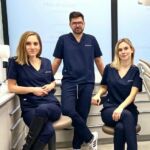What is an implant? What does it do? How does the procedure look like? Can everyone have implants? What are the advantages and disadvantages?
What is an implant? What befits does it provide?
A dental implant is a reconstruction of a lost tooth placed into the bone. It is currently the best imitation of natural tissues. An implant is a unique foreign body that undergoes a process of osseointegration. This process connects the bone with the implant surface.
Anatomy of the implant
The first implant was introduced in 1965 by Professor Brånemark. Since then, work on further development has resulted in a significant improvement and many modifications to the design of implants. It is up to the doctor to select the best model for a given case. In order to fully recreate a missing tooth, most implants need three parts: a screw that goes into the bone (the actual part is called an implant), an abutment, and a crown. Implants are made primarily of metal alloys, most often titanium, zirconium and tantalum.
What does the implant insertion look like?
The procedure of inserting a dental implant is a relatively minimally invasive procedure, definitely less stressful than tooth extraction. Most of these procedures are performed under local anesthesia. The duration of the procedure for inserting a single implant is 15 to 30 minutes. During the procedure, a small (about 2 cm) incision is made in the gum to reveal the bone. The implant bed is then prepared by drilling a hole in the bone. This procedure is less felt than removing caries from a tooth. Finally, the previously selected implant is inserted and the gingiva is sutured. Usually sutures are removed after 7 days.
Can everyone have implants?
Unfortunately, there are diseases and other factors that prevent the implant placement. The most important ones include: significant immunity disorders, some active neoplastic diseases, advanced osteoporosis, chronic decompensated diseases, significant bone loss.
In order for the implantation procedure to take place as smoothly as we have described, the most important thing is to properly plan the procedure in advance. This cannot be done without performing a conical computer tomography of the head, popularly known as CBCT. This test allows you to assess amount of bone and select the appropriate implant. Currently, computer-aided design of the implant position is additionally used and individual surgical templates are often made to assist in the perfect insertion of the implant. In a situation where we have significant bone deficiencies that do not allow for the introduction of an appropriate size implant, it is necessary to perform bone regeneration procedures. These treatments are more complicated and require a separate description.
What are the advantages and disadvantages of implants?
An alternative to replacing a missing tooth with an implant is a bridge. This is a solution that requires the presence of teeth on both sides of the missing tooth. Unfortunately, this often requires the damage of supporting teeth. In addition, food can stay under the bridge because there is a risk of space remaining between the gum and the crown of the restored tooth.
Dental implants are a great tooth reconstruction, although their damage is extremely difficult, they are not indestructible. Unfortunately, they are also more sensitive to gingivitis than teeth, so proper hygiene and periodic checkups are important.
lek. dent. Kamil Kikowicz

